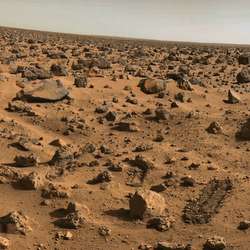
Martian atmosphere has a very low nitrogen content. Image credit: NASA. Click to enlarge
When searching for life, most researchers have been hunting the Solar System for signs of liquid water; past and present. But geobiologists from the University of Southern California think that more effort should be spent looking for evidence of nitrogen. Since nitrogen isn’t a major component in rocks and minerals but an essential component of life, any concentration of this element would strongly indicate life’s fingerprint. They hope that next generation spacecraft will have advanced nitrogen sampling capabilities.
The great search for extraterrestrial life has focused on water at the expense of a crucial element, say USC geobiologists.
Writing in the Perspectives section of the May 5 issue of Science, four USC researchers propose searching for organic nitrogen as a direct indicator of the presence of life. Nitrogen is essential to the chemistry of living organisms.
Even if NASA were to find water on Mars, its presence only would indicate the possibility of life, said Kenneth Nealson, Wrigley Professor of earth sciences in USC College.
“It’s hard to imagine life without water, but it’s easy to imagine water without life,” Nealson said.
The discovery of nitrogen on the Red Planet would be a different story.
“If you found nitrogen in abundance on Mars, you would get extremely excited because it shouldn’t be there,” Nealson said.
The reason has to do with the difference between nitrogen and carbon, the other indispensable organic element.
Unlike carbon, nitrogen is not a major component of rocks and minerals. This means that any substantial organic nitrogen deposits found in the soil of Mars, or of another planet, likely would have resulted from biological activity.
Dimming the hopes of life-on-Mars believers is the makeup of the planet’s atmosphere. The abundant nitrogen in Earth’s atmosphere is constantly replenished through biological activity. Without the ongoing contribution of living systems, the atmosphere slowly would lose its nitrogen.
The extremely low nitrogen content in the Martian atmosphere suggests that biological nitrogen production is close to zero.
However, the authors write, it is possible that life existed on Mars at some hypothetical time when nitrogen filled the atmosphere.
Co-author Douglas Capone, Wrigley Professor of environmental biology in USC College, said NASA should establish a nitrogen detection program alongside its water-seeking effort. He noted that next-generation spacecraft will have advanced sampling capabilities.
“What we’re suggesting here is basically drilling down into geological strata, which they’re going to be doing for water anyway,” Capone said.
“The real smoking gun would be organic nitrogen.”
Said Nealson: “If your goal is to search for life, it would be wise to include nitrogen.”
In their acknowledgments, the authors thanked the students of the Spring 2004 Geobiology & Astrobiology course at USC, with whom Nealson and Capone began their discussion on how to search for life outside earth.
“That’s really what stimulated this [paper],” Nealson said.
The authors also thanked NASA, the U.S. Department of Energy and the National Science Foundation for their financial support.
Along with Nealson and Capone, USC graduate student Beverly Flood and former USC research professor Radu Popa (now a professor of biology at Portland State University) contributed to the Perspectives paper.
Original Source: USC News Release
